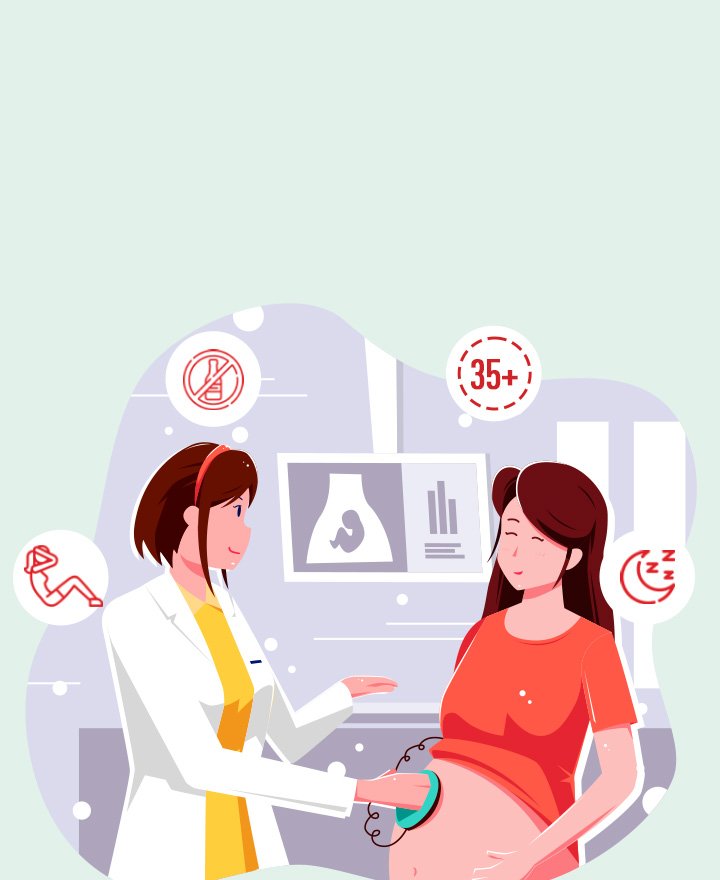High risk pregnancy – This course is designed to understand the care of pregnant women and newborn: antenatal, intra-natal and postnatal; breast feeding, family planning, newborn care and ethical issues, The aim of the course is to acquire knowledge and develop competencies regarding midwifery, complicated labour and newborn care including family planning.
High risk pregnancy
Definition of High Risk Pregnancy/Mother:
High risk pregnancy is defined as one which is complicated by factor or factors that adversely affects the pregnancy outcome – maternal or prenatal or both.
Danger Signs of Pregnancy:
1. Swelling of the feet.
2. Convulsion.
3. Blurring of vision.
4. Convulsion.
5. Per-vaginal bleeding (even in small amount).
6. Per-vaginal discharge

High Risk Pregnancies/WHO (1978) Criteria of High Risk Cases:
A. During pregnancy:
➤ Elderly primi (>30 years of age)
➤ Short stature primi (< 140 cm).
➤ Threatened abortion & antepartum haemorrhage (APH).
➤ Malpresentation.
➤ Pre-eclampsia & eclampsia.
➤ Anaemia.
➤ Elderly grand multiparas
➤ Twins & polyhydramnios.
➤ Previous history of still birth, IUD, IUGR, manual removal of placenta.
➤ Prolong pregnancy.
➤ History of previous caesarean section & instrumental delivery.
➤ Pregnancy associated with medical disease
B. During labour:
➤ Pre-mature rupture of membranes (PROM).
➤ Prolong labour.
➤ Hand, feet or cord prolapse.
➤ Placenta retained more than half an hour.
➤ Post-partum haemorrhage.
➤ Puerperal fever & sepsis,

Diagnosis or Screening of High Risk Cases:
The cases are assessed at the initial antenatal examination, preferably in the 1st trimester of pregnancy.
A. History taking:
Maternal age: Pregnancy < 17 years &> 35 years
Family history
➤ Socio-economic condition: Poor socio-economic status has a high incidence of anaemia,
➤ IUG & preterm labour etc
➤ Women who undertake long road journeys have a higher incidence of recurrent abortion or preterm labour.
➤ Family history of diabetes mellitus, hypertension, multiple pregnancy (maternal side), congenital anomalies
Obstetric history:
➤ Two or more previous spontaneous/induced abortion
➤ Previous still birth, neonatal death or birth 1 of babies with congenital anomaly nud
➤ Previous preterm or small for date or big baby (> 3kg) delivery
➤ Grand multiparity.
➤ Previous caesarean section or hysterototomy
➤ Pre-eclampsia or eclampsia.
➤ Third stage abnormalities: This has a particular tendency to recur.
➤ Previous infant with Rh-isoimmunisation or ABO incompatibility
History of medical diseases:
➤ Pulmonary disease (e.g. TB)
➤ Viral hepatitis.
➤ Cardiac disease.
➤ Renal disease.
➤ Thyroid disease,
➤ Psychiatric diseases.
➤ Epilepsy
Past surgical history:
➤ Myomectomy.
➤ Repair of vesico-vaginal fistula (VVF),
➤ Repair of complete perineal tear
➤ Repair of stress incontinence78
B. Clinical examination:
General-examination
➤ Height: < 150cm
➤ Weight: Overweight or underweight both are risk factor
➤ High blood pressure.
➤ Anaemia.
➤ Cerdiac or pulmonary diseases
Per-abdominal examination:
➤ Genital prolapse
➤ Laceration or dilataion of the cervix.
➤ Associated tumor

Follow up:
After initial visit, the high risk cases should be reassessed at each antenatal visit to detect any abnormality that might have arisen later; such as –
➤ Pre-eclampsia.
➤ Anaemia.
➤ Rh-isoimmunisation.
➤ High fever.
➤ Pyelonephritis.
➤ Haemorrhage or P/V bleeding.
➤ Diabetes mellitus.
➤ Large uterus.
➤ Lack of uterine growth
➤ Post-maturity:
➤ Abnormal presentation
➤ Twin pregnancy
➤ History of teratogenic drug intake

Read More….
